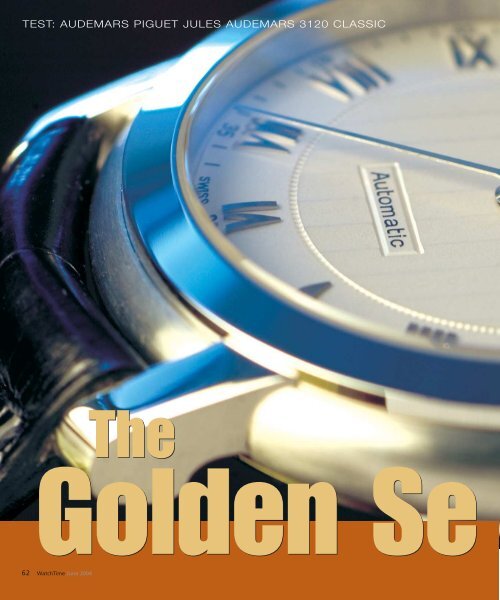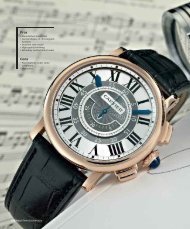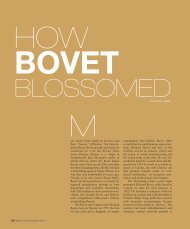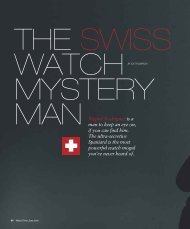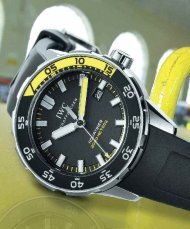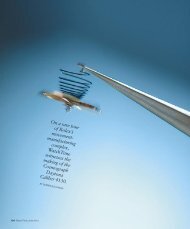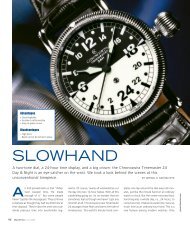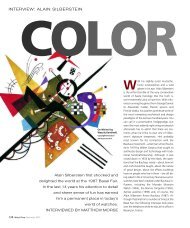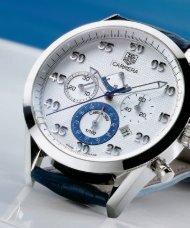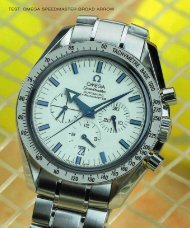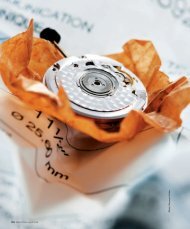wt_2004_03: test: audemars piguet jules audemars 3120 classic
wt_2004_03: test: audemars piguet jules audemars 3120 classic
wt_2004_03: test: audemars piguet jules audemars 3120 classic
Create successful ePaper yourself
Turn your PDF publications into a flip-book with our unique Google optimized e-Paper software.
TEST: AUDEMARS PIGUET JULES AUDEMARS <strong>3120</strong> CLASSIC<br />
The<br />
Golden Se<br />
62 WatchTime June <strong>2004</strong>
All photos by Christian Schörg<br />
ction<br />
With its new Caliber <strong>3120</strong>, Audemars<br />
Piguet has achieved something like the<br />
fabled "Golden Section." The two <strong>classic</strong><br />
Calibers, 2120 and 2121, served simultaneously<br />
as inspirations and reference<br />
points. models. BY ALEXANDER LINZ<br />
June <strong>2004</strong> WatchTime 63
TEST: AUDEMARS PIGUET JULES AUDEMARS <strong>3120</strong> CLASSIC<br />
Advantages<br />
+ The house of Audemars Piguet’s own<br />
exclusive mechanism<br />
+ Interesting technology<br />
+ Modern, trumpery-free design<br />
+ Appealing dial<br />
Disadvantages<br />
- The minute hand is a bit too short<br />
- Runs significantly fast in some positions<br />
- High price<br />
God is in the details: The Caliber<br />
<strong>3120</strong> is a perfect example of<br />
<strong>classic</strong>al proportion<br />
and handcraftsmanship.<br />
In the mathematical abstraction know as<br />
the "Golden Section," a line is divided into<br />
segments so that the relationship between<br />
the lengths of the longer segment and the entire<br />
line is equal to the relationship between<br />
the lengths of the shorter segment and the<br />
longer segment. When this rather abstruse<br />
idea is applied to the concrete example of the<br />
Caliber <strong>3120</strong> from Audemars Piguet, it means<br />
that the company's watchmakers and technicians<br />
approached the task of constructing this<br />
new caliber with great care and sensitivity.<br />
Whether or not they actually found the Golden<br />
Section is a question to which we'll devote<br />
this first comprehensive discussion of the new<br />
self-winding caliber.<br />
High-quality movements have been designed<br />
by Audemars Piguet in Le Brassus,<br />
Switzerland in the Vallée de Joux for many<br />
years. The family-owned business stands atop<br />
a solid financial foundation and in terms of<br />
technical expertise, the successors to the<br />
founding families (Audemars and Piguet) command<br />
plenty of know-how. Annual turnover<br />
of 210 million Swiss francs and the several<br />
hundred million Swiss francs realized from the<br />
sale of its 40% share in Jaeger-LeCoultre to the<br />
Richemont concern form the basis for the<br />
firm's policy of financial independence.<br />
Time never stands still, especially when the<br />
development of complications is concerned.<br />
As early as 1992, Audemars Piguet had already<br />
bought into Renaud & Papi, the high-tech<br />
watch smithy in Le Locle. After learning their<br />
craft at Audemars Piguet, both Renaud and<br />
Until recently, Audemars Piguet<br />
lacked a simple manufacture<br />
base caliber that they could produce<br />
in large numbers.<br />
Papi decided to go into business on their own,<br />
founding Renaud & Papi SA in 1986. Somewhat<br />
later, when the two watchmakers were<br />
searching for a partner who could guarantee<br />
their firm's continued existence; their former<br />
employer was instantly amenable to the idea.<br />
Audemars Piguet became majority shareholder,<br />
and Renaud & Papi SA was renamed Audemars<br />
Piguet (Renaud et Papi) S.A., or "APRP"<br />
for short. Their savoir-faire is impressive, and<br />
the commissions don't come only from the<br />
majority shareholder, but also from a whole<br />
slew of the most renowned luxury watchmakers<br />
in Germany and Switzerland. Audemars Piguet<br />
invested heavily in new APRP facilities<br />
when it opened an ultramodern industrial<br />
building in Le Locle on September 24, 20<strong>03</strong>.<br />
The new wing that was added to the APRP's<br />
original house offers three times more space.<br />
This was a qualitative and intelligent investment<br />
in the future. Approximately 100 special-<br />
64 WatchTime June <strong>2004</strong>
TEST: AUDEMARS PIGUET JULES AUDEMARS <strong>3120</strong> CLASSIC<br />
ists from 15 nations work there under optimal<br />
conditions, and we can expect them to give<br />
the world additional masterpieces of the<br />
watchmaker's craft in the coming years.<br />
Most manufacturers have one or more base<br />
calibers, but seldom does a brand have much<br />
experience in the construction of complicated<br />
mechanisms. This wasn't the situation at Audemars<br />
Piguet; the company had plenty of<br />
complications, but the firm lacked a base caliber<br />
of its own that could be created in large<br />
numbers. For many years, AP had relied on<br />
Jaeger-LeCoultre's (JLC) Caliber JLC 889/2 for<br />
many of its models. But with the takeover by<br />
Richemont and the sale of its shares in JLC,<br />
AP's access to that coveted caliber gradually<br />
came to an end. AP seized the initiative, and<br />
introduced the hand-wound Caliber 3090 in<br />
1999. Caliber <strong>3120</strong> followed four years later. It<br />
combines automatic winding, a sweep seconds-hand,<br />
and a numerical window-type<br />
The caseback<br />
is securely held<br />
in place with<br />
five screws.<br />
The 22-karat gold rotor is engraved<br />
with the coats-of-arms of<br />
the Audemars and Piguet families.<br />
date display. Both of these calibers now serve<br />
as the new motors in simple watches from the<br />
house of Audemars Piguet.<br />
The new Caliber <strong>3120</strong> unmistakably reveals<br />
the manufacture's signatures: a harmoniously<br />
arranged series of bridges, with assembly bespeaking<br />
the utmost in skilled craftsmanship<br />
and elaborate decorations on the individual<br />
components. The rotor is truly a wonderful<br />
sight: Crafted from 22-karat gold, it's beautifully<br />
engraved with the coats-of-arms of the<br />
Audemars and Piguet families. A connoisseur's<br />
discriminating gaze feasts on a picture of elegantly<br />
well-balanced proportions, further enhanced<br />
by the crosswise orientation of the balance-bridge.<br />
The legendary Calibers 2120 and<br />
2121 form the technical basis. The automatic<br />
Caliber 2120 was first built in 1968. Slightly<br />
modified and renamed Caliber 2121, it attracted<br />
considerable attention in 1972 when it<br />
was encased within the Royal Oak, to which it<br />
offered a date display and a sweep secondshand.<br />
Ever since, it has remained a reliable<br />
power source for several models in the AP collection.<br />
The best features of these ticking timekeepers<br />
were integrated into the new Caliber <strong>3120</strong>.<br />
Some of its characteristics are mentioned in<br />
the following list. (Information in parentheses<br />
refers to the corresponding details in the older<br />
Caliber 2120.) Here are the specs: The ballborne<br />
rotor winds the mainspring in both its<br />
DATA PAGE<br />
Jules Audemars <strong>3120</strong> Classic<br />
Manufacturer: SA de la Manufacture<br />
d'Horlogerie Audemars Piguet & Cie,<br />
CH-1248 Le Brassus<br />
Model: Jules Audemars <strong>3120</strong> Classic<br />
Reference number: 15120BC.0.A002CR.01<br />
Case number: F 0217<br />
Movement number: 589981<br />
Functions: Hours, minutes, sweep<br />
seconds-hand, and date.<br />
Movement: Audemars Piguet Caliber <strong>3120</strong>;<br />
diameter = 26.6 mm (12.5 lignes); interior<br />
diameter of the movement-holder<br />
ring = 26 mm; height = 4.25 mm; 40 jewels;<br />
21,600 beats per hour A/h (3 hertz); Swiss lever<br />
escapement; Nivarox-I flat balance-spring;<br />
Gyromax balance; ball-borne, 22-karat gold<br />
rotor winds the Nivaflex 1 mainspring in both<br />
its directions of rotation; one barrel; 60-hour<br />
(± 5%) power reserve; Kif-Elastor shock<br />
absorption for the balance; stop-seconds<br />
function; 278 individual components<br />
Case: Massive, tripartite gold case; sapphire<br />
crystal in back; five screws hold back in place;<br />
crown is not screw-down; sapphire crystal above<br />
dial; water-resistant to 20 meters<br />
Wristband and claps: Leather strap with<br />
pronged buckle made of 18 karat gold<br />
Rate <strong>test</strong> and amplitude (when tully wound;<br />
deviations in seconds per 24 hours<br />
Dial up: +6 261°<br />
Dial down: +9 302°<br />
Crown left: +1 255°<br />
Crown up: -1 254°<br />
Crown down: +8 261°<br />
Grea<strong>test</strong> difference of rate: 10 50°<br />
Average deviation: +5 275°<br />
Dimensions: diameter = 38.7 mm,<br />
height = 9.5 mm<br />
Price: $14,800 in white gold with leather strap<br />
and pronged buckle.<br />
66 WatchTime June <strong>2004</strong>
TEST: AUDEMARS PIGUET JULES AUDEMARS <strong>3120</strong> CLASSIC<br />
directions of rotation. The rotor has a centrally<br />
arranged alternator that needs no springs and<br />
thus loses no energy. The date display jumps<br />
ahead precisely at midnight. The balance is<br />
made of Gyromax. A new feature of the Caliber<br />
<strong>3120</strong> is the double balance-bridge. This<br />
component not only looks pretty, it also significantly<br />
improves the stability of the watch's<br />
rate. The balance oscillates at a pace of 21,600<br />
beats per hour (19,800). Fine adjustment is accomplished<br />
by means of eight tiny screws. The<br />
new caliber preserves the single-plane architecture<br />
for the gear trains that support both<br />
the time display and the winding mechanism.<br />
This single-stratum solution makes it possible<br />
to construct a relatively slim caliber. The overall<br />
height measures 4.25 millimeters (2.45 mm);<br />
the total diameter is 12.5 lignes or 26.6 millimeters<br />
(28 mm).<br />
When the movement plates are manufactured,<br />
the milled holes, which will later accept<br />
the screws that hold the dial in place, are<br />
beveled. The plate receives circular graining on<br />
both its sides. All of the holes in the plate are<br />
counter-pierced. The date display has an instantaneous<br />
trigger and can be rapidly adjusted.<br />
The large dimensions of the transmission<br />
The Roman numerals give it<br />
a formal elegance, but some<br />
would argue that the minute<br />
hand is a tad too short.<br />
and winding wheel, combined with the integrated<br />
unclicking system of the automatic<br />
winding mechanism, guarantee that manual<br />
winding will be problem-free and won't cause<br />
a lot of wear and tear.<br />
The barrel, the center-pinion, the centerwheel<br />
pinion, the third-wheel pinion, the thirdwheel,<br />
the fourth-wheel pinion, and the<br />
fourth-wheel are all made in the style of the<br />
good old days. The pinions are polished; all of<br />
the edges are beveled; the pivots and the tips<br />
of the pivots are rolled under pressure; the<br />
non-functional surface of the wheels is goldplated<br />
and decorated with a radial pattern; the<br />
gears' teeth are gold-plated first, then milled<br />
afterwards to guarantee that the geometry of<br />
the surfaces of the teeth is perfectly functional.<br />
The bearings for the barrel are first gold-plated,<br />
then reworked; the outer throats and the inner<br />
surface of the barrel are diamond-polished,<br />
which produces the most beautiful surfaces<br />
and leaves those surfaces as smooth as possible.<br />
The result is a long-lasting 60-hour power<br />
reserve, compared to 40 hours for the previous<br />
version. Also, the task of fine adjustment becomes<br />
significantly easier because even after it<br />
has been running for 48 hours, the watch still<br />
has plenty of power at its disposal.<br />
Our <strong>test</strong>ed watch ran quite well, but it posted<br />
somewhat less than optimal results on our<br />
electronic timing machine. This shortcoming<br />
could be due to the fact that the movement is<br />
Satin and polished:<br />
The entire impression<br />
is one of velvety<br />
softness.<br />
part of a preliminary manufacturing series<br />
made prior to regular serial production, which<br />
is scheduled to begin soon. The optimum as<br />
defined by Audemars Piguet is an average deviation<br />
of -1 to +8 seconds in all positions combined<br />
with good amplitude. Values in this ballpark<br />
were already achieved in all positions but<br />
one: with the dial down, the watch ran nine<br />
seconds too fast. The watch ran only about<br />
three seconds fast on the wrist, and that's a respectable<br />
result.<br />
The strength of this newcomer<br />
is its robustness, its accuracy<br />
and its loving details.<br />
The appeal of this newcomer is undoubtedly<br />
due to its fine mechanical qualities, its robustness<br />
and reliability, the accuracy of its rate, and<br />
the love for detail evident throughout. Features<br />
that have proved themselves in the past<br />
have been preserved and new details have<br />
been added to yield a very clever combination<br />
indeed. Movements of such superior quality<br />
have become rather rare in recent years, which<br />
is all the more reason for us to take this opportunity<br />
to praise Audemars Piguet's design engineers<br />
and watchmakers. The company has<br />
manufactured no more than 3,415 examples<br />
of the Calibers 2120 and 2121 during the past<br />
six years. Demand far exceeds the production<br />
68 WatchTime June <strong>2004</strong>
TEST: AUDEMARS PIGUET JULES AUDEMARS <strong>3120</strong> CLASSIC<br />
The balance oscillates<br />
at a pace of 21,600<br />
beats per hour.<br />
capacity, so the debut of the <strong>3120</strong> may help to<br />
ease matters somewhat. The actual production<br />
capacity for the new caliber is a secret Audemars<br />
Piguet prefers not to divulge.<br />
We wanted to get an impression of how the<br />
new caliber works in practice, so we selected a<br />
wristwatch from the Jules Audemars collection<br />
to serve as an example. This watch is named<br />
after Jules-Louis Audemars (1851-1918), who<br />
was a pioneer in the construction of numerous<br />
excellent complications. Four models are currently<br />
available with the new Caliber <strong>3120</strong>:<br />
two versions with "globe" decor and/or<br />
"globe" design on their dials, plus two <strong>classic</strong>al<br />
three-handed watches with "côtes de<br />
Highly-precise<br />
finishing helps to<br />
create a 60-hour<br />
power reserve.<br />
Genéve" decorations. All four have a windo<strong>wt</strong>ype<br />
date display. The "Classic" model in white<br />
gold was the one that we chose to serve as our<br />
<strong>test</strong> candidate. This elegant men's model<br />
makes a very fetching first impression. Its proportions<br />
and appearance harmonize quite<br />
well. The watch is neither too large nor too<br />
small. The white dial with applied Roman numerals<br />
radiates an aura of noble serenity. The<br />
legibility of the time and date is good by day,<br />
although the date window is of traditional<br />
size. "Traditional" is the best adjective to use in<br />
this context because various "big date" displays<br />
have become so commonplace nowadays<br />
and we've become so accustomed to<br />
their dimensions that a date window of conventional<br />
size tends to look somewhat small.<br />
Flipping the Jules Audemars over to peruse<br />
its back, which is held in place by five screws, a<br />
connoisseur can peer through a pane of sapphire<br />
crystal and admire the beautifully decorated<br />
rotor and the distinctive double bridges<br />
for the barrel. The case is made of white gold,<br />
with satin finishing on the sides. Sharp edges<br />
are nowhere to be found. The entire impression<br />
is one of velvety softness. The sonorous<br />
sound of the winding mechanism is delightful.<br />
It can be heard when the rotor turns or when<br />
the crown is manually twisted. The Caliber<br />
<strong>3120</strong> produces a pleasant rasping sound, not a<br />
tortured rattling of gears.<br />
As far as water-resistance goes, this watch<br />
could hardly be described as a deep diver. It's<br />
water-resistant to only 20 meters, so you'd be<br />
Setting the date<br />
is a pleasure with<br />
this impeccable<br />
caliber.<br />
TEST RESULTS<br />
Wristband and claps (max. 10 points): 8<br />
Appealing crocodile-skin strap with pronged<br />
buckle. The AP logo is engraved into the metal.<br />
Operation (5): 5<br />
Setting the hands and date is conveniently<br />
accomplished via the crown.<br />
Case (10): 9<br />
Beautiful, impeccably crafted, white gold case.<br />
Pane of sapphire crystal in back, which is held<br />
in place by five screws.<br />
Design (15): 12<br />
Appealing, contemporary design. Very<br />
beautiful, elaborately designed dial, but<br />
the minute hand is too short.<br />
Legibility (5): 4<br />
Good legibility of the time under normal conditions.<br />
The watch's face remains dark at night.<br />
Wearing comfort (10): 10<br />
Very good wearing comfort, pleasant size.<br />
Movement (20): 18<br />
AP Caliber <strong>3120</strong> with automatic winding and<br />
date window - a valuable and beautiful base<br />
caliber.<br />
Rate results (10): 7<br />
Ran too fast in some positions: +5 seconds fast<br />
per day on the timing machine, +3 seconds fast<br />
per day on the wrist.<br />
Overall value (15): 13<br />
A reasonably sized man's wristwatch with an<br />
unostentatious appearance on the outside and<br />
a high-quality mechanism on the inside. The<br />
fine quality, however, has its price.<br />
TOTAL: 86 points<br />
better advised to keep it and water more or<br />
less apart. A few extra meters of water-resistance<br />
wouldn't have hurt. Another minor cavil<br />
is that the minute hand is a wee bit too short.<br />
An unwritten law in the world of <strong>classic</strong>al<br />
watchmaking specifies that its tip ought to be<br />
tangent to the minute-circle.<br />
Is this watch an example of the<br />
Golden Section In our opinion, Audemars<br />
Piguet has created a superlative<br />
new item with its Caliber<br />
<strong>3120</strong>. The people in Switzerland's<br />
Jura region haven't lost<br />
sight of tradition. They've succeeded<br />
in combining the best<br />
from the past with the best of the<br />
present. Old and new unite beautifully<br />
here. The existing line has<br />
been divided so that the relationship<br />
between the longer segment and the total<br />
stretch is equal to the relationship between the<br />
shorter segment and the longer segment. Any<br />
further questions<br />
70 WatchTime June <strong>2004</strong>


